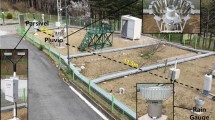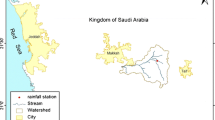Abstract
With regard to extreme events, it is well documented that an intensity of about 1 mm/min already represents an extreme intensity. Under alpine conditions, a precipitation event with an intensity of 3 mm/min has occurred. Therefore, the rain gauges in this region have to be able to measure in this and even in higher intensity ranges. This study deals with basic automated tipping-bucket rain (TBR) gauge and Bulk precipitation samplers, which are able to hold more than 95 % of the cumulative rainfall, that are verified within the space of the week without losses during the extreme events and with minimal evaporation loss. Bulk samplers collected more rainfall than TBR gauges in 110 of 221 extreme events analysed over the past 10 years. In 17 extreme events, an underestimation greater than 10 % was evaluated. The objective was to single out the counting errors associated with TBR gauge, during extreme events, so as to help the understanding of the measured differences between instruments in the field. We want to determine whether the automated precipitation gauge can provide a reliable and precise measurement of precipitation with particular interest regarding heavy and extreme events.











Similar content being viewed by others
References
Allis JA, Harris B, Sharp AL (1963) A comparison of performance of five rain-gage installations. J Geophys Res 86:4723–4729
Calder R, Kidd CHR (1978) A note on the dynamic calibration of tipping-bucket gauges. J Hydrol 39:383–386
Ciampittiello M (1999) I livelli del Lago Maggiore: una grande risorsa da gestire un problema da affrontare. Alberti Editore
Ciampittiello M (2009) Le precipitazioni atmosferiche nell’areale del Lago Maggiore. Atti del Convegno I laghi Maggiore e Lugano: Quale futuro? 18 ottobre 2008 Gazzada (VA). CIPAIS. Franco Angeli
Galloway JN, Likens GE (1976) Calibration of collection procedures for the determination of precipitation chemistry. Water Air Soil Poll 6:241–258
Galloway JN, Likens GE (1977) The collection of precipitation for chemical analysis. Tellus 30:71–82
Habib E, Krajewski WF, Kruger A (2001) Sampling error of tipping-bucket rain gauge measurement. J Hydrol Eng 6(2):159–166
Habib E, Meselhe EA, Aduvala AV (2008) Effect of local errors of tipping-bucket rain gauges on rainfall-runoff simulations. J Hydrol Eng 13(6):488
Humphrey MD, Istok JD, Lee JY, Hevesi JA, Flint AL (1997) A new method for automated calibration of tipping-bucket rain gauges. J Atmos Ocean Technol 14:1513–1519
CESI Centro Elettrotecnico Sperimentale Italiano (2004) Monitoraggio delle deposizioni atmosferiche e calcolo del trend SCENARI/MONAMB/WP3/Milestone 3.2. Rapporto 1/1 della Milestone
La Barbera P, Lanza LG, Stagi L (2002) Tipping bucket mechanical errors and their influence on rainfall statistics and extremes. Water Sci Technol 45(2):1–9
Lanza LG, Stagi L (2009) High resolution performances of catching type rain gauges from the laboratory phase of the WMO field intercomparison of rain intensity gauges. Atmos Res 94(4):555–563
Lanza LG, Vuerich E (2009) The WMO field intercomparison of rain intensity gauges. Atmos Res 94:534–543
Lombardo F, Stagi L (2004) Pluviometri a bascula: correzione degli errori strumentali e taratura della strumentazione. Rivista Ligure di Meteorologia. www.nimbus.it/liguria/rlm39/copertina/html
Maksimović Č, Bužek L, Petrović J (1991) Corrections of rainfall data obtained by tipping bucket rain gauges. Atmos Res 27:45–53
Marsalek J (1981) Calibration of the tipping bucket raingauge. J Hydrol 53:343–354
Molini A, La Barbera P, Lanza LG, Stagi L (2001) Rainfall intermittency and the sampling error of tipping-bucket rain gauges. Phys Chem Earth (C) 26(10–12):732–742
Molini A, La Barbera P, Lanza LG, Stagi L (2002) L’errore sistematico meccanico dei pluviometri a vaschette basculanti: ricostruzione e correzione delle serie storiche. 28° Convegno di Idraulica e Costruzioni idrauliche. Potenza 16–19 settembre
Molini A, Lanza LG, La Barbera P (2005a) The impact of tipping-bucket raingauge measurement errors on design rainfall for urban-scale applications. Hydrol Process 19:1073–1088
Molini A, Lanza LG, La Barbera P (2005b) Improving the uncertainty of rain intensity records by disaggregation techniques. Atmos Res 77:203–217
Mosello R, Marchetto A, Tartari GA (1988) Bulk and wet atmospheric deposition chemistry at Pallanza (N. Italy). Water Air Soil Pollut 42:137–151
Ntegeka V, Willems P (2008) Trends and multidecadal oscillations in rainfall extremes, based on a more than 100-year time series of 10 min rainfall intensities at Uccle, Belgium. Water Resour Res 44:W07402. doi:10.1029/2007WR006471
Rogora M, Mosello R, Arisci S, Brizzio M, Barbieri A, Balestrini R, Waldner P, Schmitt M, Stähli M, Thimonier A, Kalina M, Puxbaum H, Nickus U, Ulrich E, Probst A (2006) An overview of atmospheric deposition chemistry over the Alps: present status and long-term trends. Hydrobiologia 562:17–40
Russo M, De Blasio A, Fornaciari C, Di Loreto E, Liperi L (1997) Norme tecniche per la raccolta e l’elaborazione dei dati Idrometeorologici—Parte I—Dati meteorologici a fini idrologici. Presidenza del Consiglio dei Ministri Dipartimento per i Servizi Tecnici Nazionali. Servizio Idrogafico e Mareografico Nazionale. Istituto Poligrafico e Zecca dello Stato
Siek LC, Burges SJ, Steiner M (2007) Challenges in obtaining reliable measurements of point rainfall. Water Resour Res 43:W01420. doi:10.1029/2005WR004519
Smith RL (1987) Estimating tails of probability distributions. Ann Stat 15:1174–1207
Tartari GA, Arisci S, Brizzio MC, Marchetto A, Mosello R, Pranzo A (2002) Manuale per le operazioni di campionamento. Report CNR-ISE. 02-02
Tokay A, Hartmann P, Battaglia A, Gage KS, Clark WL, Williams CR, (2008) A field study of reflectivity and Z-R relations using vertically pointing radars and disdrometers. J Atmos Ocean Tech 22. doi:10.1175/2008JTECHA1163.1
Tokay A, Bashor PG, McDowell VL (2010) Comparison of rain gauge measurements in the mid-atlantic region. J Hydrometeorol 11(2):553–565
Tropeano D, Turconi L (2004) The Marderello catchment (Western Alps, Italy): a ten-year survey on geomorphodynamical processes with special regard to debris flows, ERB2004—Euromediterranean conference: progress in surface and subsurface water studies at the plot and small basin scale. 13–17 ottobre 2004, Torino, pp 288–292
Turconi L, Tropeano D, Gabriele S (2008) Debris flows in the Marderello catchment in Summer 2005 (Cenischia Valley, Western Italian Alps): a critical rainfall-process analysis, Wildbach und Lawinenverbau, 72, Heft 158, pp 42–61
Vasvári V (2005) Calibration of tipping-bucket rain gauges in the Graz urban research area. Atmos Res 77:18–28
Vuerich E, Monesi C, Lanza LG, Stagi L, Lanzinger E (2009) The WMO field intercomparison of rainfall intensity (RI) gauges in Vigna di Valle (Italy), October 2007–April 2009: relevant aspects and results. TECO-2010 Helsinki, Finland, St. Petersburg, Russian Federation, 28–29 November 2008
Wilks DS (1995) Statistical methods in the atmospheric sciences: an introduction. Academic Press, New York, p 467
WMO World Meteorological Organisation (2006) Laboratory intercomparison of rainfall intensity gauges—instruments and observing methods, report no. 84. 2006—WMO/TD—no 1304
WMO World Meteorological Organisation (2008) Guide to meteorological instruments and methods of observation. WMO-N° 8
WMO World Meteorological Organisation (2009) Instrument and observing methods. WMO field intercomparison of rainfall intensity gauges—instruments and observing methods, report n° 99. 2009—WMO/TD—N° 1504
WMO World Meteorological Organisation (2010) Commission for instruments and methods of observation—fifteenth session, Helsinki 2–8 September 2010. WMO n° 1064. Abridged final report with resolutions and recommendations
Acknowledgments
We would like to thank Mrs. Lindsay Schwarting for the careful language revision of the manuscript. We are grateful to the anonymous reviewers whose suggestions allowed us to improve the presentation of our results.
Author information
Authors and Affiliations
Corresponding author
Rights and permissions
About this article
Cite this article
Saidi, H., Ciampittiello, M., Dresti, C. et al. Extreme rainfall events: evaluation with different instruments and measurement reliability. Environ Earth Sci 72, 4607–4616 (2014). https://doi.org/10.1007/s12665-014-3358-7
Received:
Accepted:
Published:
Issue Date:
DOI: https://doi.org/10.1007/s12665-014-3358-7




